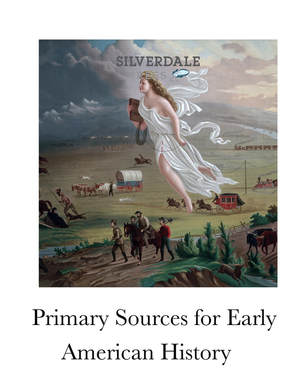 Primary sources are documents, images, and artifacts that provide direct evidence about what happened in history. Textbook authors can distort the truth. The best way for students to gather knowledge, and to get unbiased information, is to go straight to the source: the primary source. If you are teaching early American history in your homeschool this year, do not neglect primary sources. In this age where textbook authors make villains out of great leaders, writers, thinkers, and citizens, it is helpful to see these people for who they really were—not perfect but advancing civilization nevertheless. At Silverdale Press, our unit studies rely heavily on primary sources, including some of those listed below. So if you want to use primary sources in your homeschool but don’t know how, our studies take away all of the prep work and guess work for parents. Many homeschool families like to cover American history every year. If you are one of those families, in addition to our unit studies, check out this list of 30 primary sources on early American history. This list would be great to tuck away in your inbox for the future or to use right now if you are preparing for next school year! The list is in chronological order from colonial America to the Civil War. 30 Primary Sources for Teaching Early American History 1 Thomas Hariot’s A Brief and True Report of the New Found Land of Virginia. One of the first written eyewitness accounts of North America. https://archive.org/details/briefetruereport00haririch 2 In 1585, John White made watercolor drawings of the Algonquin people. He made them to give the people back home in England an idea about what was in the New World: http://www.virtualjamestown.org/images/white_debry_html/jamestown.html 3 University of Cincinnati’s Center for the Electronic Reconstruction of History and Archaeological Sites has digital restorations of Ohio Valley Mounds and a virtual reconstruction of pre-Columbian mounds: www.earthworks.uc.edu/ 4 The original narrative of the first white man to cross North America, Cabeza de Vaca: http://www.americanjourneys.org/pdf/AJ-070.pdf 5 The Trans-Atlantic Slave Trade Database has information on 36,000 slaving voyages, in which millions of Africans were transported to the Americas from the 1500s to 1800s. http://www.slavevoyages.org/ 6 This Website has information on the settlement at Jamestown: www.virtualjamestown.org 7 Poems of Anne Bradstreet, wife of the governor of the Massachusetts Bay Colony, provide insight into puritan marriage. Find some of them here: https://www.poemhunter.com/anne-bradstreet/ 8 Plimoth Plantation www.plimoth.org: This website is maintained by a living history museum south of Boston, Massachusetts. Its Website contains a number of primary sources, including Pilgrim letters. 9 See the New Netherland Institute www.newnetherlandinstitute.org for primary sources on the Dutch colonization in New York. 10 Examine portraits of colonial children via the Colonial Williamsburg Foundation: http://www.history.org/Foundation/journal/Summer05/children.cfm?showSite=mobile-regular 11 Project Gutenberg has the Autobiography of Benjamin Franklin, one of the greatest sources on one of our most famous founders. https://www.gutenberg.org/files/20203/20203-h/20203-h.htm 12 Sermons of George Whitefield: www.crta.org/documents/Whitefield.html Visit this site for primary documents on the first Great Awakening. It includes speeches and sermons of the Rev. Whitefield. 13 The Massachusetts Historical Society has all of the letters John and Abigail Adams wrote to each other. It is a treasure trove of primary information about this historic couple. https://www.masshist.org/digitaladams/archive/letter/ 14 Want to read what ignited revolutionary fervor? Check out Thomas Paine’s pamphlet Common Sense: http://www.gutenberg.org/ebooks/147 15 Valley Forge National Historical Park Museum Collections has primary sources on the American Revolution, George Washington, and the Continental Army: https://www.nps.gov/vafo/learn/historyculture/museum.htm 16 Edited by Sarah Josepha Hale, the Godey’s Lady’s Book was the women’s magazine of choice during the early Republic and through the 1890s. The Hathi Trust has a number of them. https://catalog.hathitrust.org/Record/000050287 17 The Center for Lowell History has great information on working girls in this early American mill town. https://www.uml.edu/library/ 18 The Avalon Project at Yale University has digitized the Federalist Papers, a series of essays by Hamilton, Madison, and Jay that provided a rationale for ratifying the U.S. Constitution: http://avalon.law.yale.edu/subject_menus/fed.asp 19 The University of Virginia houses the Papers of George Washington: www.virginia.edu/gwpapers 20 Princeton University houses the Papers of Thomas Jefferson: www.jeffersonpapers.princeton.edu: 21 This government site provides documents on pioneer life in Michigan, Minnesota, and Wisconsin: http://memory.loc.gov/ammem/umhtml/umhome.html 22 If your student is interested in the law, the Library of Congress maintains this site: American Memory: Slaves and the Courts, 1740–1860 http://lcweb2.loc.gov/ammem/sthtml/sthome.html 23 Don’t miss out on the Narrative of the Life of Frederick Douglass, a slave who taught himself to read and escaped. Gutenberg has it: http://www.gutenberg.org/ebooks/23?msg=welcome_stranger#link2HCH0001 24 Check out Uncle Remus, His Songs and Sayings for insight on the cultural lives of slaves: http://www.gutenberg.org/ebooks/2306 25 The National Park Service maintains this Website for the Seneca Falls women’s rights convention. http://www.nps.gov/wori/index.htm: 26 If you want to learn about Westward expansion, look no further than the Overland Trail Diaries from the Oregon-California Trail Association: http://www.octa-journals.org/journals 27 See Harper’s Weekly Historical Cartoons for political cartoons from the 1800s www.harpweek.com/ 28 The Lincoln-Douglas debates launched Abraham Lincoln into national prominence. Read them at the National Park Service Website: https://www.nps.gov/liho/learn/historyculture/debates.htm 29 Harpers Ferry National Historical Park http://www.nps.gov/hafe/index.htm is the official U.S. government website for the national park that contains the remains of the 1859 Harpers Ferry raid by John Brown. 30 The Civil War was captured in Mathew Brady’s famous photographs. Photography was a new technology at this time. The Library of Congress has the images: http://www.loc.gov/pictures/collection/cwp/
1 Comment
|
Silverdale PressCheck out our About Page to learn more about us! Categories |

 RSS Feed
RSS Feed